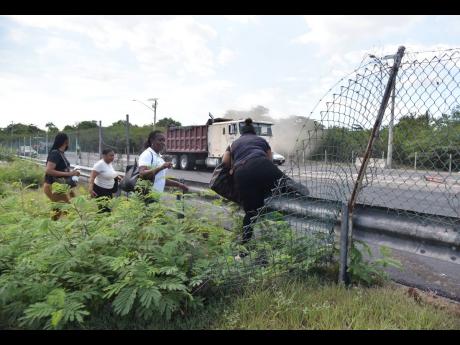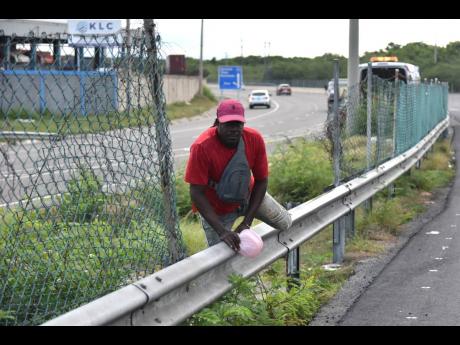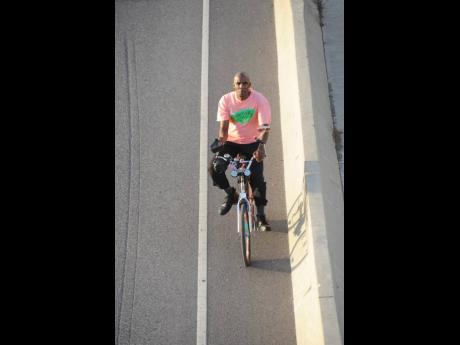Deadly dash
Pedestrians flirting with danger in prohibited trek across major highways
It is a matter of timing. Moving too fast or too slow could easily get them a deadly date with destiny as motor vehicles bark down the major highways across the island. The warning signs are large, clear and strategically placed along the highways...
It is a matter of timing.
Moving too fast or too slow could easily get them a deadly date with destiny as motor vehicles bark down the major highways across the island.
The warning signs are large, clear and strategically placed along the highways that meander across the island: No pedestrians. No cyclists.
But in defiance of repeated warnings, pedestrians and cyclists still risk it, often breaking down the barriers built to keep them out and ignoring the possibility of being penalised. Sometimes smiling in the face of danger, and at other times quivering after near-death experiences, they dart across the busy thoroughfares meant for motor vehicles only.
Since 2021, at least six persons have died trying to cross sections of Highway 2000.
Robert Taylor, who was killed on July 20, was the latest among them. He was mowed down by a Toyota Coaster bus at the entrance to the Portmore toll road in the vicinity of Marcus Garvey Drive in the Corporate Area, after he tried to cross the road with friends.
Reports are that the bus driver swung to avoid a collision with the group, but unlike his friends, Taylor tried running back across the road and ended up in the path of the oncoming vehicle.
Since former Prime Minister P.J. Patterson launched the Highway 2000 project in 1999, with the objective to improve Jamaica’s road infrastructure and eventually create a highway system that would link right across the island, operators have invested heavily in barriers and perimeter fencing to prevent animals and individuals from walking across the busy thoroughfares. But they face an ongoing problem of having to replace them, as persons continue to break down the fencing to make their way across what is considered a danger zone.
Jamaica Infrastructure Operators (JIO), which operates the East-West corridor of Highway 2000, said that last year it spent $16.5 million – 12 per cent more than the 2020 sum – for maintenance, which primarily included the rehabilitation and replacement of fences along the stretch.
According to Nicole Kuster, head of administration and communications at JIO, there are a few areas along the corridor where fence maintenance has been particularly routine.
Perhaps most problematic, however, is the section at the entrance of the Portmore toll road, opposite the Kingston Logistics Centre, where there is a footpath created by pedestrians bent on crossing the highway.
Last week, a section of the fence dangled openly.
“That area has been fixed several times, and each time they destroy it,” Kuster emphasised during an interview with The Sunday Gleaner. “What they are doing is a very dangerous practice. At no time should anyone be crossing the highway.”
But some violators who spoke to The Sunday Gleaner on Friday were amused that the authorities had caught on to their habit of destroying the fence every time it was fixed. Most are workers in and around the Kingston Wharves and were adamant that without an overhead bridge, especially in that vicinity, they had no convenient alternative.
“The [overhead] bridge down the road is too far and besides, people rob workers on the bridge. Last week, they held up a man right there,” said a lady, who identified herself as Shelly, pointing in the direction of a metal bridge closer to the Tinson Pen Aerodrome.
Just then, a young lady voiced her annoyance as she was startled by a motorist who intentionally swerved in her direction as she crossed.
“Don’t fix the fence because it is going to tear down. Build an overhead bridge right here because we are not walking all the way down the road,” offered one man, who said he had been crossing the highway to and from work for eight years.
Fisherman Winston O’Neil said he is used to police stopping him on his bicycle ride and telling him he can’t use the highway en route to his favourite fishing spots on the old causeway.
“Me a do this long before toll road, 30-plus years me a do fishing and security work. A lot of time police pull down on me and tell me not to ride on the highway,” he said, noting that he rides on the side of the road towards oncoming vehicles for safety.
He added: “More often we bicycle men help the motorists, too. Any time dem tyre blow out or dem run out of gas, is we dem call and we go and buy the gas for them.”
AMENDMENTS NEEDED
Under the Toll Road Act, any person guilty of maliciously or forcibly breaking, damaging or destroying any property of a concessionaire is liable to a fine of up to $200,000 or up to six months’ imprisonment.
Additionally, any person found “riding, driving or being upon any carriage, bicycle, tricycle or other similar machine on the toll road” could be fined up to $50,000 or sent to prison for up to 30 days upon conviction.
The act, however, makes no mention of punishment for pedestrians, explained Delon Wauchope, senior toll road inspector at the Toll Authority of Jamaica.
“The main challenge posed by pedestrians is the fact that the police are not able to prosecute them until the Toll Road Act is amended and a fine is added for breaches,” explained Wauchope.
At the start of this year, Audley Gordon, executive director of the National Solid Waste Management Authority, came under police scrutiny following a fatal accident in which he was involved on the toll road.
According to reports, Gordon was driving his Toyota Prado SUV near Linstead in St Catherine, about 5 p.m. when he hit Donovan Mignott, a mechanic of Treadways district in St Catherine, who was walking on the pavement along the Edward Seaga Highway, which runs from north to south. Mignott later died.
When contacted by The Sunday Gleaner, Mignott’s daughters declined to speak at length on the matter, only admitting that their father was wrong to be on the highway, and saying that the family was just trying to get over the loss.
Mignott had reportedly been helping a woman across the toll road when the incident occurred.
The status of that investigation remained unclear up to press time.
According to JIO statistics, between January and March this year, there were 24 accidents attributed to driver error, while there were 93 for all of 2021 along both the East-West and North-South corridors of the highway. For the same period, there were also six accidents attributed to speeding, while that number was 54 for all of 2021. There were at least five accidents attributed to blown tyres this year, while 32 accidents due to blown tyres for all of 2021.





